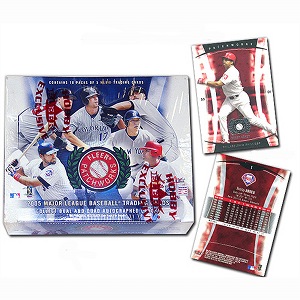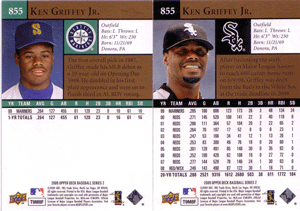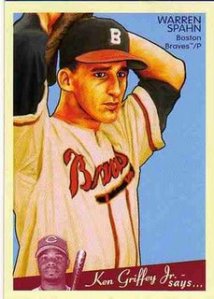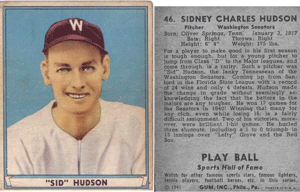2009 UD Goodwin Champions
Base set completion: 74 of 150 (49%)
Short print set completion: 16 of 40 (40%)
Super short print set completion: 4 of 20 (20%)
Goodwin Champions was the only other 2009 UD release — aside from the flagship — that I had been looking forward to. It’s hard to not to be enamored with the modern reincarnations of the early 20th-century tobacco inserts.
Having seen the previews, it looked as though for once, UD had chosen to actually exercise some creativity sorely lacking in their baseball releases. Interestingly enough, it’s been pointed out that there doesn’t appear to be any lack of creativity in UD’s basketball or hockey releases.
I should’ve known better. In a year in which UD has shown just miserable effort in baseball, UD once again failed to deliver the goods. A  150-card base set is nice, but a 40-card short print set and a 20-card “super” short-print set should’ve been warning enough that this would be yet another epic fail from UD.
150-card base set is nice, but a 40-card short print set and a 20-card “super” short-print set should’ve been warning enough that this would be yet another epic fail from UD.
Sure, 150 base cards is a good number, but when packs come with only five cards, it makes it that much more difficult to complete a set. It gets even more difficult when those five-card packs would often come with more than one mini-card. It gets frustrating when every other one of those five-card packs came with those absolutely pointless 20th anniversary cards.
And that hasn’t even touched on the awful collation. Two hobby boxes produced a pathetic 74 cards out of the base set. Not even half.
It’s amusing how this was being touted, pre-release, as being UD’s answer to Allen & Ginter. What a pathetic failure it instead turned out to be. If this was the answer to A & G, I’d hate to think of what the question was.
All of these issues hinder what really could’ve been a fantastic release from UD. There’s no doubt about it — these are some wonderfully beautiful cards. After striking Masterpieces from their lineup, and with Goudey being yet another epic fail, Goodwin Champions really had the potential to make a statement for UD. It did, but sadly, I doubt it’s the one UD wanted to make.
As I’ve mentioned before — I’m looking forward to the day UD ceases to produce baseball cards. Their 2009 releases may very well serve to be their epitaph. It’s sad to think that a company that was once on the edge of innovation has become so stale and lifeless.
2009 Topps Ticket to Stardom
Base set completion: 198 of 200 (99%)
Imagine this idea: buy a single hobby box, complete (or come pretty close to) the base set. Mind you, I’m not accusing Topps of somehow  understanding the type of consumer I am — the sort that wants a little more bang for my buck. Nonetheless, Topps delivers in this regard, with an $84 hobby box packed with 12-card packs (who does that anymore?) yielding just about the entire base set.
understanding the type of consumer I am — the sort that wants a little more bang for my buck. Nonetheless, Topps delivers in this regard, with an $84 hobby box packed with 12-card packs (who does that anymore?) yielding just about the entire base set.
The base cards themselves are nothing out of the ordinary. They obviously bring to mind the old Fleer Authentix sets. I also think they look a little derivative of this year’s Finest base cards as well. That said, TTS’s design, while it borrows elements from those two sets, doesn’t appear to be a carbon copy either.
 But what really sets TTS apart are its relic cards. Typically, I don’t care much for relic cards. But after pulling the ones I did, I actually contemplated keeping them rather than sending them straight to the trading block as I normally do. How often do you see boring, generic relic card designs these days? More often than not — which as an aside, makes it all the more confusing to me why anyone even bothers packsearching most non-premium product — relic cards are really just throwaway cards. But TTS shows a lot more effort on the part of Topps’ designers, I feel, than I’ve seen in recent releases. It’s no Donruss Prime Patches, but for a mid-range product? I’ll take it.
But what really sets TTS apart are its relic cards. Typically, I don’t care much for relic cards. But after pulling the ones I did, I actually contemplated keeping them rather than sending them straight to the trading block as I normally do. How often do you see boring, generic relic card designs these days? More often than not — which as an aside, makes it all the more confusing to me why anyone even bothers packsearching most non-premium product — relic cards are really just throwaway cards. But TTS shows a lot more effort on the part of Topps’ designers, I feel, than I’ve seen in recent releases. It’s no Donruss Prime Patches, but for a mid-range product? I’ll take it.
Topps has really done well this year with its products. It’ll be interesting to see whether or not they can carry that momentum into next year’s dramatically different landscape. While UD will still have its brand recognition, let’s face it — non-MLB-licensed cards is Donruss territory. And other than 08’s Threads, all of Donruss’ non-MLB-licensed card releases were mediocre, to put it gently.






 While I’m clearly a sucker for the obvious retro-themed sets (i.e. Heritage, Masterpieces, etc.), it does seem a little odd to look to the overproduction era for inspiration. Then again, I dove in and went after both 08 Timeline and 07 SP Rookie Edition, so perhaps even the 80s/90s era has untapped potential.
While I’m clearly a sucker for the obvious retro-themed sets (i.e. Heritage, Masterpieces, etc.), it does seem a little odd to look to the overproduction era for inspiration. Then again, I dove in and went after both 08 Timeline and 07 SP Rookie Edition, so perhaps even the 80s/90s era has untapped potential. Speaking of hearkening back to the past, I found the “Unsung Heroes” subset particularly interesting in that it reminded me so much, visually, of all of those late-80s drugstore issues. I remember those cards well — every time we’d drop by a Sav-On Drug or Woolworths, I’d beg forever and ever for a pack. Mom and dad rarely relented, but I did manage to save at least two sets — 1988 Topps Woolworth and 1988 Topps Kmart.
Speaking of hearkening back to the past, I found the “Unsung Heroes” subset particularly interesting in that it reminded me so much, visually, of all of those late-80s drugstore issues. I remember those cards well — every time we’d drop by a Sav-On Drug or Woolworths, I’d beg forever and ever for a pack. Mom and dad rarely relented, but I did manage to save at least two sets — 1988 Topps Woolworth and 1988 Topps Kmart. than those cheap cardboard 50-cents-a-pack regular issues. Two decades later, I came to the sad realization that they weren’t worth much in dollars, but they were certainly worth the childhood nostalgia. Their lack of value, however, hasn’t stopped some folks from locking them up in PSA holders, however.
than those cheap cardboard 50-cents-a-pack regular issues. Two decades later, I came to the sad realization that they weren’t worth much in dollars, but they were certainly worth the childhood nostalgia. Their lack of value, however, hasn’t stopped some folks from locking them up in PSA holders, however.
















